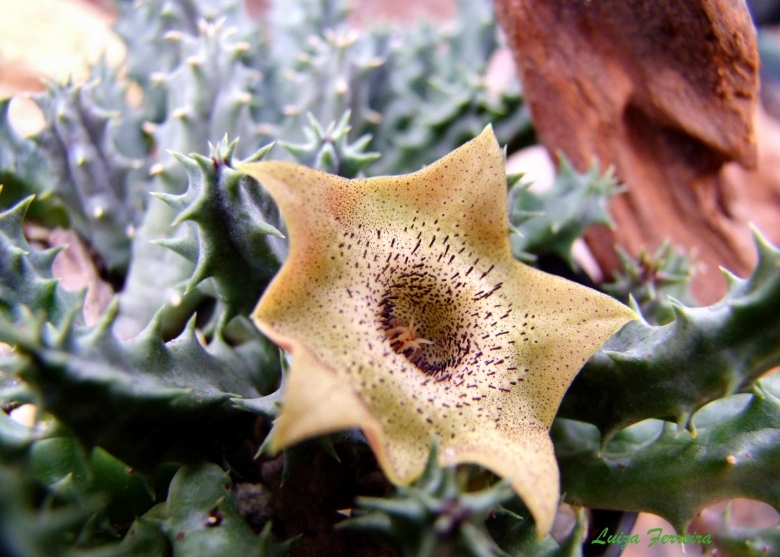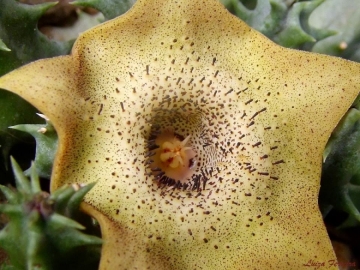




Your support is critical to our success.

PVB 7119
Origin and Habitat: From Laingsburg to Vanwyksdorp in the Little Karoo, Western Cape, Republic of South Africa.
Habitat and ecology: Succulent Karoo. It grows in stony slopes or flattish areas between small hills with hard, loamy soils. Grows well hidden under small bushes.
Synonyms:
- Huernia praestans N.E.Br.
Description: Huernia praestansSN|27753]]SN|30600]] is a small perennial succulent species with very short, purple and green mottled acutely-angled stems and relatively large, showy flowers at the stem base. The corolla is greenish-yellow, with small purple dots. the only slightly raised annulus more heavily spotted, the markings becoming confluent in the tube. The disc has large creamy papillae tipped with stout purple hairs. The rough papillate corolla aligns it more closely with Huernia brevirostrisSN|30600]]SN|27753]].
Stems: Erect or ascending, 2.5-5 cm long, about 12 mm thick including the teeth, acutely 4-angled, glabrous, deep green mottled with purple. Teeth 3-4 mm long, spreading, acute, slightly recurved at the tips.
Flowers: From near the base of the young stems. Pedicels short, glabrous; sepals 6-7 mm long, narrowly lanceolate-attenuate, glabrous. Corolla apparently somewhat turbinate and flat- or broad-topped, with a short acute point, when expanded about 35-45 mm across. Tube campanulate about 6 mm long and 12 mm in diameter outside. Limb abruptly and horizontally spreading from the tube, convex and ring-like around its pentagonal mouth. Corolla-lobes slightly ascending and recurved, about 12 mm long and rather more in breadth, deltoid, acute; outside glabrous and smooth, creamy, tinted with purplish and marked with purple veins and spots; inside densely and very minutely papillate on the lobes, with stiffly erect stout clavate dark purple hairs 0.5-1 mm long seated on stout conical creamy papillae covering the disk or annulus and extending in 5 triangular areas down to about the middle of the tube; lobes greenish-yellow, marked with impressed purple dots and densely dusted with purple, with the inside of the tube and the disk around its mouth creamy, thickly marked with dull purple spots, much larger than those on the lobes and more or less confluent into rather crowded irregular lines in the tube, the base of which is entirely dark purple and shining; outer corona 5-lobed, with a small obtuse tooth alternating with the lobes, black; lobes 1 mm long, 2 mm broad, transversely oblong, emarginate; inner corona-lobes subulate, 3 mm long, somewhat connivent-erect at the lower half, with diverging tips, dark purple-brown, not nearly reaching to the mouth of the tube.
Fruits: The fruit are paired spindle-shaped capsules (follicles), with the tightly packed seeds inside. At maturity they split open to release numerous small brown seeds crowned with long white hairs.
Bibliography: Major refrerences and further lectures
1) Bruyns, P.V. 2005. "Stapeliads of southern Africa and Madagascar." (Vol. 1, pp. 1-330). Umdaus Press, Pretoria.
2) N. E. Brown. “Flora Capensis” Vol 4, page 518, 1909
3) Excelsa Taxon. Ser. 4: 34-36 (1988).
4) List South. African Succ. Pl. : 26 (1997).
5) Victor, J.E. 2011. "Huernia praestans N.E.Br." National Assessment: Red List of South African Plants version 2014.1. Accessed on 2015/02/22
6) Doreen Court “Succulent Flora of Southern Africa” CRC Press, 01 June 2000
7) Focke Albers, Ulrich Meve “Illustrated Handbook of Succulent Plants: Asclepiadaceae: Asclepiadaceae” Volume 4 Springer Science & Business Media, 2002
8) James Cullen, Sabina G. Knees, H. Suzanne Cubey “The European Garden Flora Flowering Plants: A Manual for the Identification of Plants Cultivated in Europe, Both Out-of-Doors and Under Glass” Cambridge University Press, 11/August/2011

Huernia praestans Photo by: Luiza Ferreira
The gallery now contains thousands of pictures, however it is possible to do even more. We are, of course, seeking photos of species not yet shown in the gallery but not only that, we are also looking for better pictures than those already present. Read More...
Cultivation and Propagation: Huernia praestansSN|30600]]SN|30600]] is a xerophytic plant adapted to dry soils, that it is happy in any average succulent house.
Potting:Since roots are quite shallow, use a soft and incoherent cactus mix or add extra perlite or pumice to regular soil potting soil, and clay pots help the plants to dry out between watering.
Waterings: Huernias require moderately watering through the growing season but enjoy plenty of water and some fertiliser in hot weather, this helps them to flower freely. Water more sparingly in winter according to temperatures. But, as with most asclepiads, it is unwise to leave them wet in cold weather.
Fertilization: Fertilizers for succulent plants must be rich in potassium, but poor in nitrogen, to avoid the plants from developing excess vegetation, which is easily attacked by fungal diseases.
Sun Exposure: As with many succulents, they prefer to grow in the light shade of scrubby shrubs or between rocks where they get some shade during the day. In summer it is advisable to position this plant in a partially shady place, where it is exposed to direct sunlight only during the coolest hours of the day.
Hardiness: These plants don't like cold weather, therefore in the Spring it is best to set them outside only when the temperatures are above 15°C. Can endure temperatures below 5°C for short period, but only if the soil stays completely dry.
Pest and diseases: Huernias species vary in their susceptibility to rotting, but are generally fairly easy to grow, especially if kept pest-free. They are very susceptible to stem and root mealy bugs, and damage from these may well initiate fungal attack. If you do have problems with a stem or with basal rotting, you can reliably isolate the healthy parts, dry them off, and re-root them in moist compost.
Cultural Practices: Re-pot every 2 years.
Propagation: Easiest with stem cuttings. Allow cuttings to dry a day before planting. Stems must be laid (Not buried) on gritty compost and will then root from the underside of the stems. It can also be increased from seeds sowing in spring in moist, sandy peat moss. Barely cover seeds. Seeds germinate quickly.
| Your Actions | |
|---|---|
| Back to Huernia index | |
| Back to Asclepiadaceae index | |
 |
Back to Succulents Encyclopedia index |
Privacy stantement - Terms and conditions - How to cite - About us - Feedback - Donate




